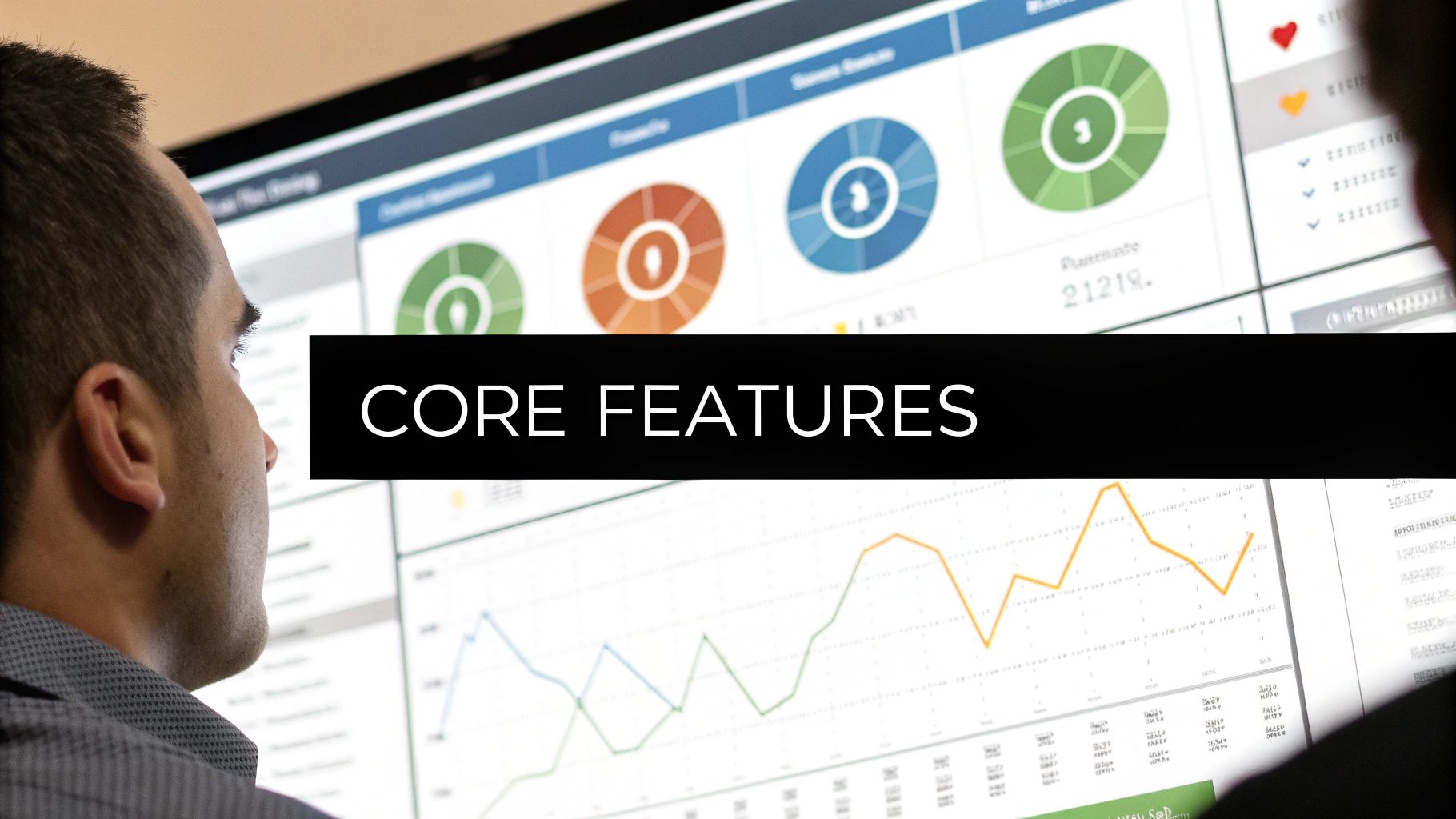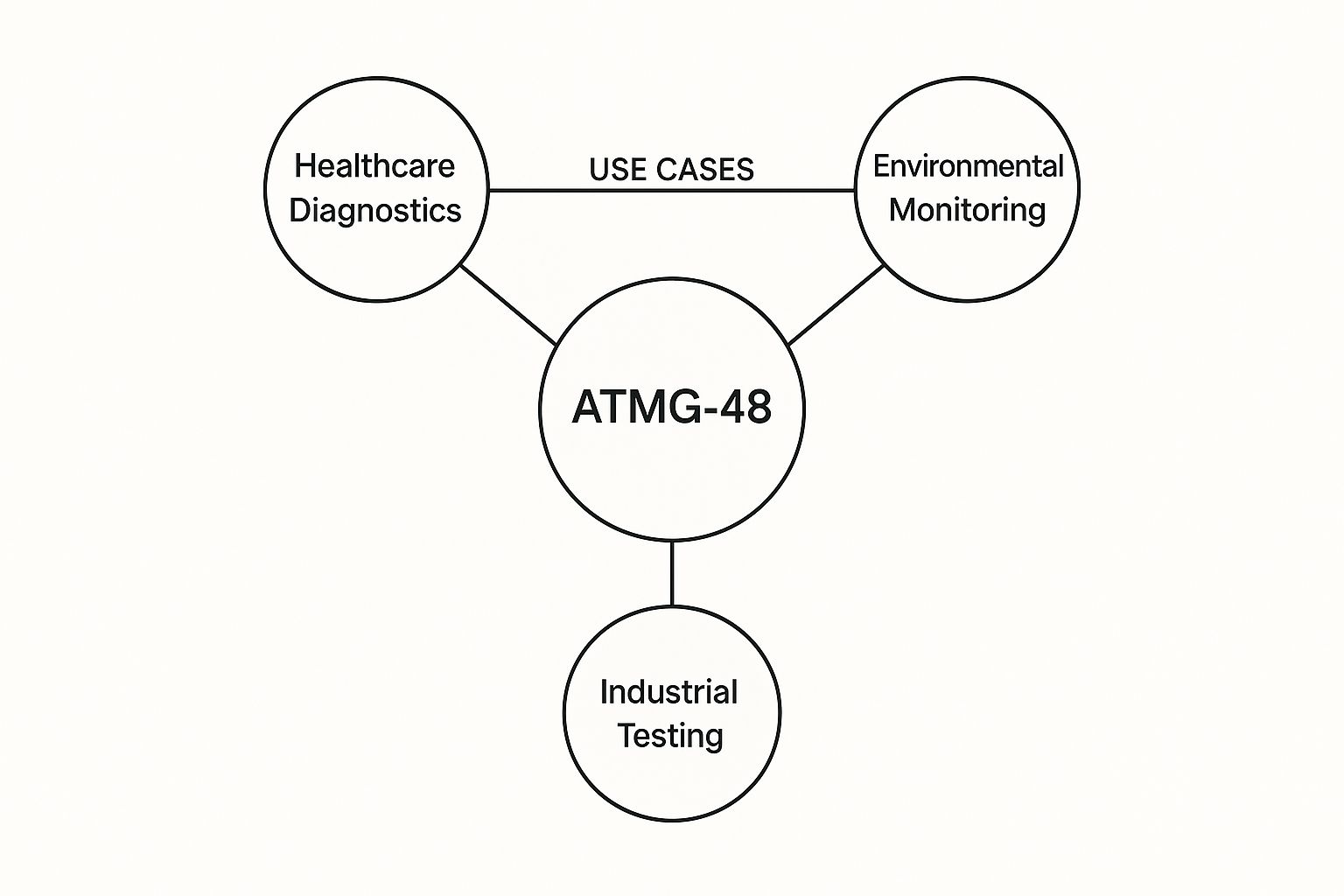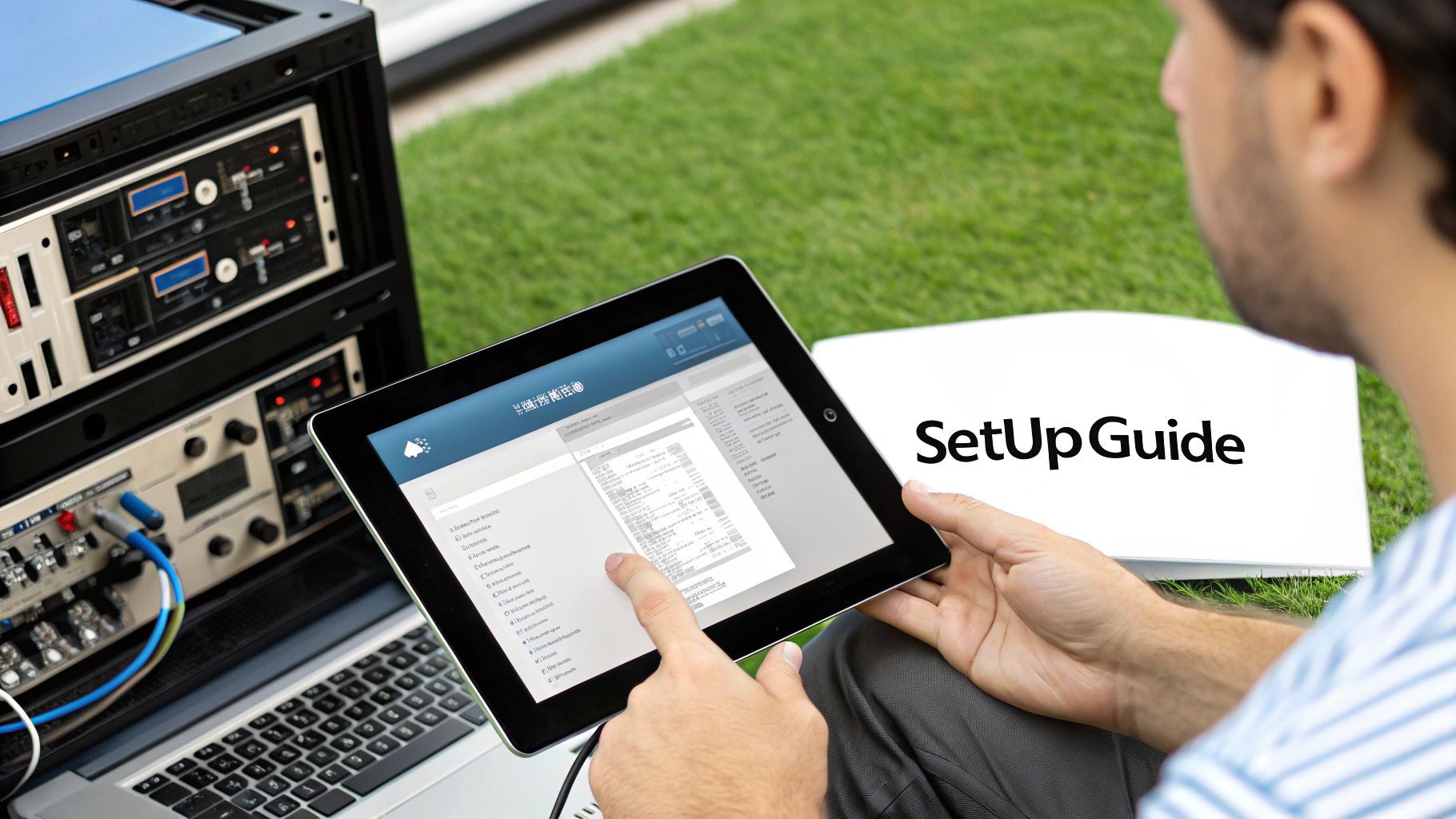
Your Essential ATMG-48 Commercial Griddle Guide
If you've ever worked the line in a high-volume commercial kitchen, you know there's one piece of equipment that's the absolute heart of the operation. The ATMG-48 is exactly that—a 48-inch manual gas griddle built to take a beating and keep on cooking, day in and day out. It's the kind of reliable flat-top that professional chefs stake their reputation on.
This commercial griddle wasn't designed for the faint of heart. It's engineered specifically for the chaos of breakfast, lunch, and dinner rushes in restaurants, diners, and food service establishments, delivering the consistent heat and durability you need when ticket times are on the line.
What Makes The ATMG-48 A Kitchen Workhorse

Peek behind the counter of any slammed diner or successful fast-casual spot, and you'll see the engine that drives the whole kitchen. For countless establishments, that engine is the ATMG-48. This is more than just a piece of stainless steel; it's the foundation of your production line, built to perform when the pressure is on.
So, why do so many kitchen managers and professional chefs swear by it? It boils down to one simple word: reliability. Whether you're flipping endless stacks of pancakes at dawn or searing hundreds of burger patties for the evening rush, you need heat you can count on in a commercial setting.
The Heartbeat of High-Volume Cooking
Think of this commercial griddle as the unsung hero of your kitchen's output. Its heavy-duty construction is designed for one thing: to survive the daily grind of a commercial environment without breaking a sweat. It’s a true workhorse.
Here's what sets it apart when things get busy:
- Consistent Heat Delivery: No more chasing hot and cold spots. This commercial griddle gives you a uniform cooking surface, so every inch is ready to work. That means better food quality and faster service.
- Rapid Temperature Recovery: Tossing cold or frozen food onto a griddle can kill its temperature. The ATMG-48 bounces back fast, ensuring you get a perfect sear every single time.
- Unmatched Durability: This commercial-grade unit is built like a tank. With heavy-gauge materials, it’s a long-term investment that will pay for itself over years of faithful service.
At its core, the ATMG-48 commercial griddle is all about empowering chefs to cook great food, fast. Its rock-solid performance means better efficiency, shorter ticket times, and a kitchen that runs like a well-oiled machine.
When it comes down to it, the power and resilience of this commercial griddle make it a cornerstone of any serious kitchen. It provides the dependable, high-performance platform you need to execute a diverse menu with absolute precision.
Understanding The ATMG-48 Design And Specifications

So, what makes the ATMG-48 such a workhorse for commercial kitchens? It’s not just one thing, but a combination of smart design choices and solid materials. This griddle is built from the ground up to handle the relentless pace of a commercial kitchen, starting with its corrosion-resistant stainless steel body. It’s tough, for sure.
But the real magic happens on the cooktop. The ATMG-48 features a massive, ¾-inch thick polished steel griddle plate. This isn’t just a slab of metal; it’s a thermal battery. Its sheer mass is engineered to soak up and hold an incredible amount of heat.
The Power Of Thermal Mass
That heat retention is the secret weapon for consistent cooking in a professional environment. When you throw a dozen frozen burger patties or cold veggies onto the griddle, a thinner plate would see a massive temperature drop, ruining the sear. Not here. The thick plate holds onto its heat, delivering a powerful, consistent cook every single time. This also means recovery times are lightning-fast, so you're ready for the next ticket without missing a beat.
A commercial griddle plate's thickness directly impacts its ability to retain heat and recover quickly. The ATMG-48's design focuses on maintaining surface temperature, which is the key to consistent cooking results during high-volume service.
To get a better feel for how this powerhouse performs in the real world, check out our full review of the Atosa griddle lineup for more context. It really helps to see how the specs translate into day-to-day benefits on the line.
Let's break down the key numbers and what they actually mean for your commercial kitchen.
ATMG-48 Technical Specifications at a Glance
This table cuts through the jargon, showing you how each feature gives you a practical edge.
| Specification | Detail | Practical Benefit |
|---|---|---|
| Cooking Surface | 48" W x 20.7" D | Provides a massive cooking area to handle multiple orders and diverse menu items at once, boosting productivity in a commercial setting. |
| Griddle Plate | ¾-Inch Thick Polished Steel | Delivers superior heat retention and eliminates temperature drops, ensuring a perfect sear and fast recovery times. |
| BTU Output | 120,000 BTU (30,000 per burner) | Offers immense cooking power for rapid preheating and maintaining high temperatures during peak service hours. |
| Construction | Stainless Steel Body & Legs | Ensures long-lasting durability, resists corrosion, and simplifies daily cleaning and sanitation routines in a tough commercial environment. |
When you add it all up, the specs paint a clear picture: this is a commercial machine built for power, consistency, and durability.
How to Master Heat Control and Cooking Zones
Any seasoned professional chef will tell you that true griddle mastery isn't about sheer power—it's about control. This is where the ATMG-48 really comes into its own, letting a good cook turn its massive 48-inch surface into a versatile stage for multiple dishes at once. How? Through its four independent, manually controlled burners.
Each burner commands its own 12-inch section of the cooktop. This setup is the key to creating distinct cooking zones. Imagine this: you can have the far-left burner cranked up high for a hard sear on steaks, the two middle burners holding a steady medium for sautéing onions, and the far-right burner on low to gently toast buns or keep finished food warm. That's not just cooking; that's workflow optimization for a commercial kitchen.
Engineering Consistent Heat
So, what's happening underneath that thick steel plate? The ATMG-48 uses powerful, U-shaped burners. This is a bigger deal than it sounds. Cheaper, straight-tube burners are notorious for creating annoying hot and cold spots, forcing you to constantly move food around. The U-shape design, on the other hand, spreads the heat far more evenly across each zone.
This means you get a remarkably consistent temperature within each zone you've set up. During a busy service, that kind of reliability is everything. It takes the guesswork out of the equation so you can focus on cooking, not chasing the "sweet spot" on your commercial griddle.
The ability to set and hold different temperatures across the griddle allows a single person to juggle multiple, completely different orders simultaneously. This zoning capability can seriously boost a kitchen's output without adding a single piece of new equipment.
The infographic below shows just how critical this kind of precise control is for a wide range of commercial applications.

Ultimately, understanding how to use these cooking zones is what separates a good griddle cook from a great one. It’s the secret to unlocking a whole new level of efficiency in your commercial kitchen.
Your Guide to Safe Installation and Setup

Getting your ATMG-48 commercial griddle set up correctly from the jump is the key to a long and happy relationship with this piece of equipment. Think of it as laying a solid foundation—doing it right ensures safety, top-notch performance, and years of reliable cooking. Let's walk through the professional installation process.
First things first: location. This commercial griddle needs some breathing room to work safely and prevent overheating. You absolutely must have a minimum clearance of 6 inches from any combustible surfaces on the sides and back. It's also non-negotiable to place it under a commercial-grade ventilation hood to manage all that smoke and grease vapor.
Connecting and Leveling Your Griddle
With your commercial griddle in its new home, it's time to hook up the gas. The ATMG-48 ships with a pressure regulator, and you must use it. This little piece is critical for feeding the griddle a steady, safe stream of gas. The exact hookup will depend on whether you’re running on natural gas or propane. They’re not interchangeable, so it’s important to learn more about natural gas vs propane for commercial kitchens to get it right.
Once the gas line is secure, you need to level the griddle. Grab an adjustable wrench and tweak the legs until the unit is perfectly level from side to side. But here’s the trick: you want a slight tilt from back to front.
This subtle forward angle is a pro tip for grease management in a commercial kitchen. It ensures that all rendered fats and oils flow directly into the grease trap, preventing messy overflows and potential slip hazards on the kitchen floor.
The final step before you fire it up for service is seasoning the griddle plate. This simple but essential process builds that perfect non-stick surface that makes cooking a dream. A properly seasoned ATMG-48 is the secret to great food and dramatically easier cleanup in a professional setting.
Daily Cooking Techniques for Maximum Efficiency
Alright, your ATMG-48 commercial griddle is installed, seasoned, and ready to make you money. Now it's time to move from setup to service. Mastering a few key daily techniques is what will turn this big slab of steel into the heart of your kitchen's output.
The first, and most important, step is the preheat. Don't skip it, and don't rush it. You need to give that heavy-duty ¾-inch thick steel plate time to soak up heat evenly. This is what creates incredible thermal stability, giving you that perfect, consistent sear from corner to corner that keeps customers coming back. Cutting this short will only lead to hot and cold spots, uneven cooking, and slower ticket times when you're slammed.
Managing Temperatures for a Diverse Menu
Once the griddle is hot, the real art begins: managing your cooking zones. This is where the ATMG-48's independent burner controls become your best friend. By setting up different temperature zones across the flat-top, you can fire multiple parts of a dish at the same time, which absolutely crushes ticket times.
Think about a classic breakfast rush in a diner:
- Zone 1 (High Heat - 375-400°F): This is your searing zone. Get those sausage patties and bacon strips sizzling here for a perfect crisp.
- Zone 2 (Medium Heat - 325-350°F): Perfect for pancakes and French toast. Hot enough to cook through and get that beautiful golden-brown color without burning the outside.
- Zone 3 (Low Heat - 225-250°F): Think of this as your holding and delicate-cooking area. It’s ideal for finishing up scrambled eggs, warming tortillas, or keeping finished items hot for plating.
A well-managed commercial griddle surface allows a chef to orchestrate an entire meal without ever turning to a different station. This efficiency is the key to handling high-volume service smoothly and consistently.
Smart Food Placement Strategies
Beyond just temperature, where and how you place food on the griddle makes a huge difference. The biggest rookie mistake is overcrowding. Piling food too close together traps steam, which means you're steaming your food instead of searing it. No one wants a pale, steamed burger.
Instead, work in clean, organized rows. Leave enough room between each item so your spatula can get in there for a clean flip.
When you're slinging burgers, for instance, lay them down in a grid pattern. This does two things: it makes the most of your massive 48-inch surface and creates a simple "first on, first off" system. You'll know exactly which patty to flip next, ensuring every single one is cooked just right. It's these small, smart habits that make the ATMG-48 feel less like a tool and more like an extension of a professional chef's hands.
Essential Maintenance to Protect Your Investment
Your ATMG-48 is built like a tank, but its day-in, day-out performance really boils down to one thing: consistent care. A clean commercial griddle isn't just about passing a health inspection; it directly affects how your food tastes, how evenly the surface heats, and ultimately, how long your equipment lasts.
Think of it like caring for a prized cast-iron skillet, just scaled up for a commercial kitchen. The goal is simple—keep the cooktop clean and protected. This breaks down into a few non-negotiable daily habits and some deeper cleaning tasks for the weeks and months ahead.
Daily Cleaning Habits
The most critical part of your maintenance routine happens right after service, while the griddle is still warm (but not screaming hot).
- Scrape the Surface: Grab a good quality griddle scraper and push all the food bits and grease into the grease trap. Doing this while the surface is warm makes a world of difference.
- Empty the Grease Trap: Don't skip this. An overflowing grease trap is a safety and sanitation nightmare. Empty it after every single service and give it a quick wash.
- Wipe and Protect: Once scraped, wipe the surface with a damp, lint-free cloth. After it's dry, rub a very thin layer of cooking oil across the steel. This simple step is your best defense against rust.
This whole process takes maybe five minutes, but it prevents that stubborn, caked-on gunk and ensures you're ready to fire up a clean commercial griddle tomorrow morning.
A well-maintained commercial griddle plate develops its own natural, non-stick surface over time. We call this "seasoning," and it's the real secret to getting a perfect sear and having food release cleanly.
Building up that perfect seasoning is fundamental. For a complete walkthrough, check out our guide on how to season a new griddle—the same principles apply to keeping it in top shape. Stick to these routines, and your ATMG-48 will perform flawlessly for years.
Got Questions About the ATMG-48? We've Got Answers.
Anytime you bring a new piece of commercial equipment into the kitchen, a few questions are bound to pop up. We've been there. Here are the straight-up answers to the most common things chefs and managers ask about the ATMG-48 commercial griddle.
How Do I Season the ATMG-48 for the First Time?
First things first, you've got to get that factory coating off. Just give the griddle plate a good wash with warm, soapy water, then rinse and dry it completely. No puddles left behind.
Now for the fun part. Fire up the griddle to a medium-low heat—think 300-350°F. Grab a clean, lint-free cloth and apply a super-thin layer of a high-smoke-point oil (canola is perfect) across every inch of the surface.
Let that oil heat up until it just starts to smoke, then kill the heat and let it cool down on its own. You'll want to repeat this whole process two or three more times. This builds up that beautiful, black, non-stick surface that makes a commercial griddle a joy to cook on.
What's the Best Way to Clean This Thing After a Busy Service?
The trick is to clean it while it’s still warm, but not screaming hot. Use a good griddle scraper and push all the leftover bits and grease right into the grease trap.
For those stubborn, cooked-on spots, pour a little warm water or club soda directly on them. The steam will pop that gunk right off. Scrape it one more time, wipe the surface down, and you’re almost done.
The final, crucial step: rub a whisper-thin layer of cooking oil over the surface. This protects the steel overnight and keeps rust away.
Your ATMG-48 commercial griddle thrives on creating and maintaining its seasoning. This simple cleaning routine not only keeps it sanitary but also reinforces the non-stick surface, making every cook easier than the last.
Honestly, this little daily habit is the single best thing you can do to make sure your investment cooks like a champ for years to come.
Ready to make the ATMG-48 the new workhorse of your commercial kitchen? Explore our full selection of commercial griddles and find the perfect fit for your operation at Griddles.com. Upgrade your line today by visiting us at https://griddles.com.
